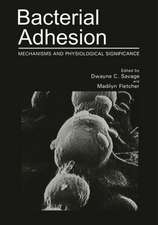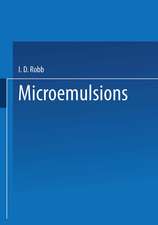The Release of Genetically Modified Microorganisms—REGEM 2: F.E.M.S. Symposium Series, cartea 63
Editat de Duncan E.S. Stewart-Tull, Max Sussmanen Limba Engleză Paperback – 26 sep 2011
Preț: 642.03 lei
Preț vechi: 755.33 lei
-15% Nou
Puncte Express: 963
Preț estimativ în valută:
122.85€ • 128.59$ • 102.25£
122.85€ • 128.59$ • 102.25£
Carte tipărită la comandă
Livrare economică 31 martie-14 aprilie
Preluare comenzi: 021 569.72.76
Specificații
ISBN-13: 9781461276548
ISBN-10: 1461276543
Pagini: 288
Ilustrații: 286 p.
Dimensiuni: 170 x 244 x 15 mm
Greutate: 0.46 kg
Ediția:Softcover reprint of the original 1st ed. 1992
Editura: Springer Us
Colecția Springer
Seria F.E.M.S. Symposium Series
Locul publicării:New York, NY, United States
ISBN-10: 1461276543
Pagini: 288
Ilustrații: 286 p.
Dimensiuni: 170 x 244 x 15 mm
Greutate: 0.46 kg
Ediția:Softcover reprint of the original 1st ed. 1992
Editura: Springer Us
Colecția Springer
Seria F.E.M.S. Symposium Series
Locul publicării:New York, NY, United States
Public țintă
ResearchCuprins
Plenary Lectures.- Environmental Pressure Imposed on GEMMOs in Soil.- Interactions in Communities of Microorganisms.- Application of Genetically-modified Microorganisms in Agriculture.- Bioremediation and Waste Management.- Progress in the Genetic Modification and Field-release of Baculovirus Insecticides.- Exploitation of Genetically-modified Microorganisms in the Food Industry.- Live Attenuated Salmonellae: Oral Vaccines for Salmonellosis and Combined Vaccines Carrying Heterologous Antigens.- Commercial Use of Microbial Inocula Containing Live Genetically Modified Microorganisms (GEMMOs).- Risk Assessment.- Social Implications and Public Confidence: Risk Perception and Communication.- Workshops.- Workshop 1: Persistence and Survival of Genetically-Modified Microorganisms Released into the Environment.- Workshop 2: Detection Methods for Modified Organisms in the Environment.- Workshop 3: Environmental Impact.- Posters (Unrefereed).- Characterization of Microbial Emissions from a Fermentation Plant Using a Genetically-Modified Bacillus Strain.- Transfer of Inc.P and Inc.Q Plasmids in Soil and Filter Matings from Pseudomonas fluorescens to a Recipient Strain and to Indigenous Bacteria.- Impact of Introducing Genetically-Modified Microorganisms on Soil Microbial Community Diversity.- The Detection and Survival of Recombinant Pseudomonas putida Populations in Lake Water.- Survival of Introduced Bacteria in Rhizosphere and Non-Rhizosphere Soils.- Implementation of Pre-Tests for GEMMO Release in the Environment.- Plasmid Transfer and Stability of Pseudomonas cepacia and Enterobacter cloacae in a Continuous Flow Culture System.- Risk Assessment in Releases of Nitrogen-Fixing Enterobacter into Soil; Survival and Gene Transfer, as Influenced by Agricultural Substrates.- DirectDetection of E. agglomerans DNA Sequences in Soil.- The Survival of Microorganisms in the Open Air.- Survival and Dispersal of GEMMOs Associated with Animals.- Study of Intestinal Colonization with Norfloxacin In Vivo and In Vitro.- Studies on Gene Flux by Free Bacterial DNA in Soil, Sediment and Groundwater Aquifer.- Plasmid Transfer Between Pseudomonas aeruginosa Strains in Natural Soils.- Investigation of Possible Gene Transfer from Genetically Modified to Indigenous Bacteria in Soil.- Fate of Plant Pathogenic Pseudomonads in Bean Microcosms.- Detection of Streptomyces Marker Plasmids in Soil.- The Removal and Dispersal of Foliar Bacteria by Rain Splash.- Growth and Survival of Genetically-Modified Pseudomonas putida in Soils of Different Texture.- Simplified Subtraction-Hybridization System for Isolation of Strain-Specific Rhizobium DNA Probes.- Plasmid Transfer of pBR322 Derivatives from recA-E. coli K12 Donor Strain to Various Natural Gram-Negative Isolates.- Single Cell Detection of Bioluminescent Pseudomonas syringae in Soil.- Luminescence-Based Detection to Assess Survival and Activity of a Genetically-Modified Inoculum in Soil.- The Effect of Cyanobacterial Water Bloom Formation upon Conjugational Gene Transfer between Associated Heterotrophic Bacteria.- Construction and Detection of Bioluminescent Bacillus subtilis Strains.- Detection of Lux-Gene Sequences in Escherichia coli MM294 Extracted from Soil Using The Polymerase Chain Reaction and Gene Probing.- Monitoring Survival of Genetically-Modified Rhizobium in the Field.- Quantitative Detection of Genetically-Modified Microorganisms by the PCR-MPN Method.- Bioluminescent RECA Mutants of Rhizobium as Model Organisms in Risk Assessment Studies.- An Artificial Microcosm to Study Microbial Interactions in the Rhizosphere.- Detection of Bacteria from Natural Environments by Flow Cytometry.- The Detection of Bacteria in Aquatic Environments by Row Cytometry.- Bacillus thuringiensis as a Model Organism for Evaluating Risks of Release of GEMMOs.- Plasmid Mediated Resistance to Hexavalent Chromium in Agrobacterium.- Plasmid Transfer in Sterile Soil as Influenced by a Non-simultaneous Inoculation of Donor and Recipient.- Survival of Enterobacter cloacae on Leaves and in Soil Detected by Immunofluorescence Microscopy in Comparison with Selective Plating.- Genetic Manipulation of Rumen Bacteria.- Detecting Natural Transformation of Acinetobacter calcoaceticus, In Situ, Within Natural Epilithon of the River Taff.- The Survival of a Chloramphenicol Resistance Plasmid in a Natural Bacillus population.- Summary.- What Values in the GEMMOs? Reflections on REGEM 2.





























